Why you can trust Tom's Hardware
AMD is already selling every 3900X it can punch out at premium pricing, so there's little impetus to bring the Ryzen 9 3900 to the enthusiast market at a lower price point. It's really a shame this processor isn't coming to the retail market as it would present a great value option for budget builders, particularly for small form factor systems. In either case, AMD's new Eco Mode feature allows you to downshift a Ryzen 9 3900X to a 65W TDP and receive the same type of performance we've measured today.
The Ryzen 9 3900 holds incredible promise for AMD's OEM and System Integrator (SI) initiatives. AMD is steadily chipping away at Intel's market dominance in the DIY market, but the OEM market comprises a much larger share of the overall picture. By leveraging the advantages of its process lead over Intel, AMD has created quite the compelling part for pre-built systems.
If you're chasing power efficiency, dropping back down the voltage/frequency curve can often yield great results, which means AMD can extract a surprising amount of performance within a much lower power envelope. And that's exactly what we observed in our test suite.
Below we plot the geometric mean of our gaming test suite in both average fps and 99th percentile values, the latter of which is a good indicator of the overall smoothness of your gaming experience.

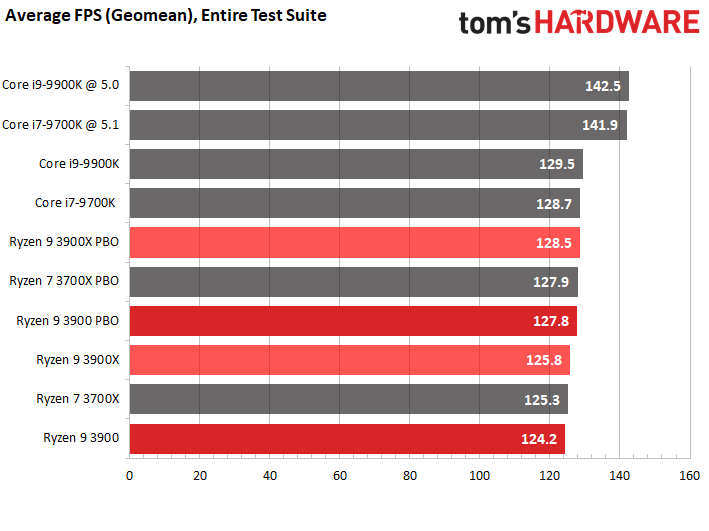
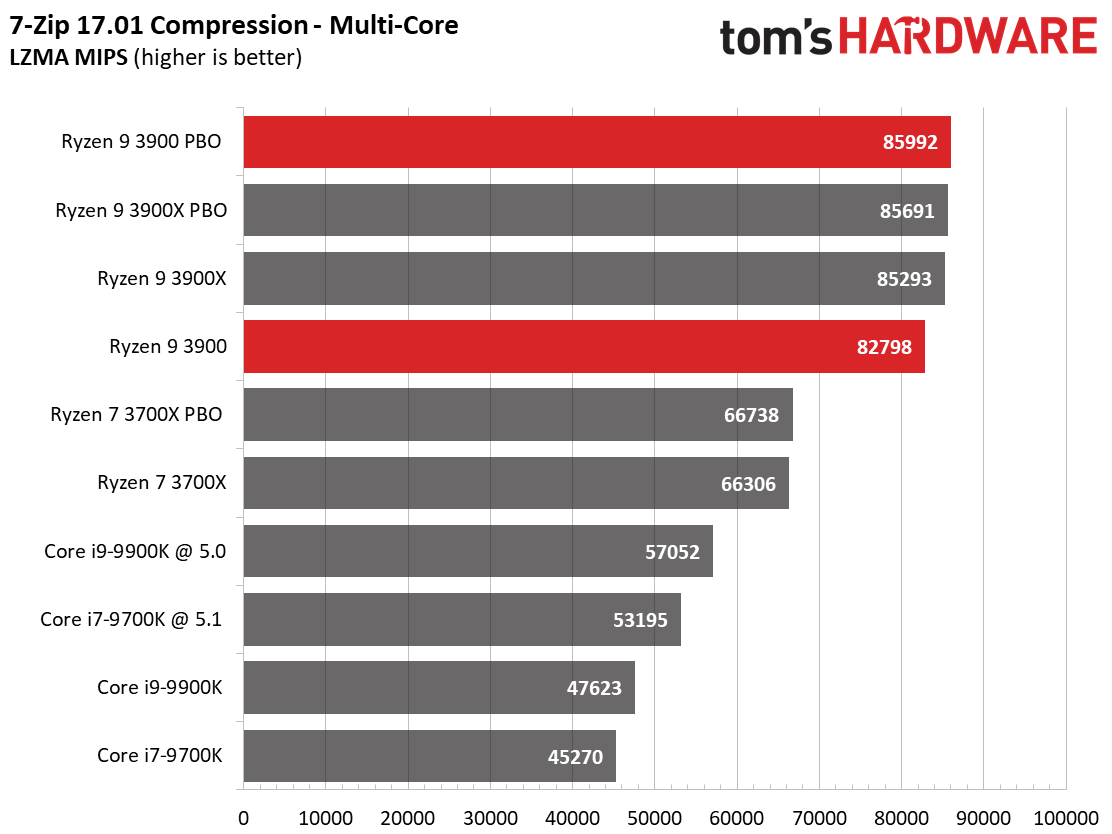
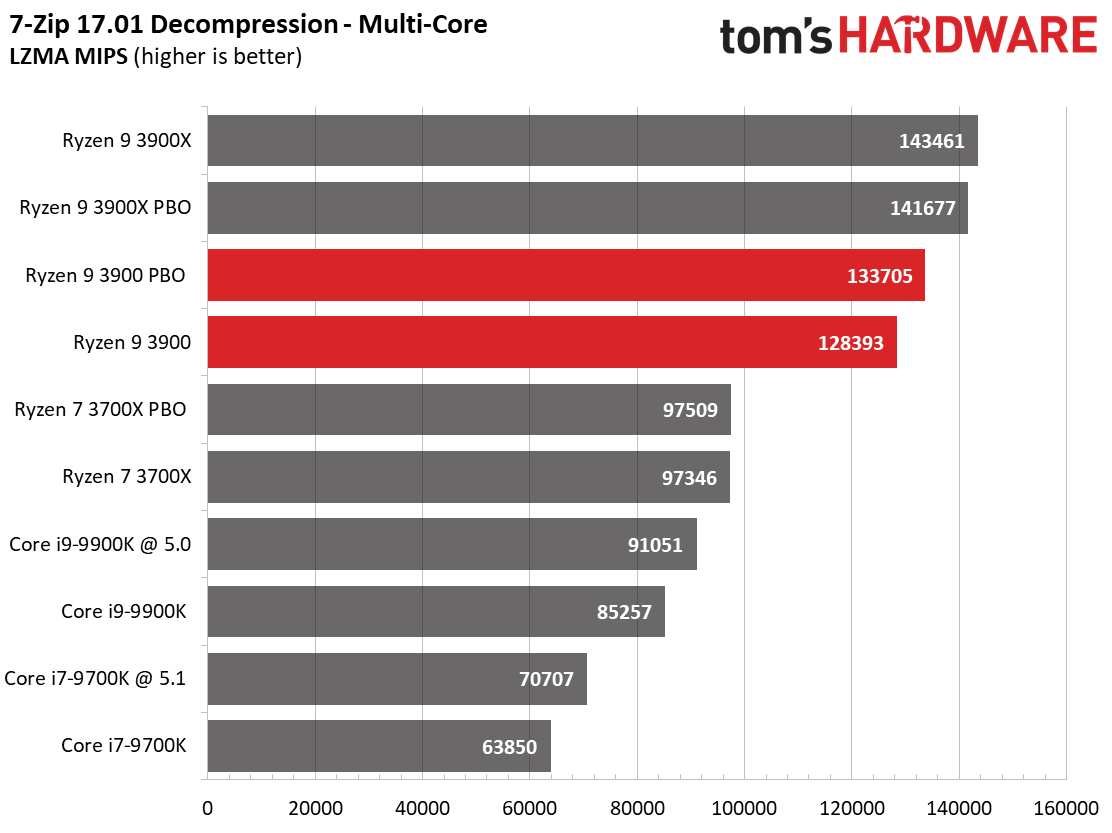
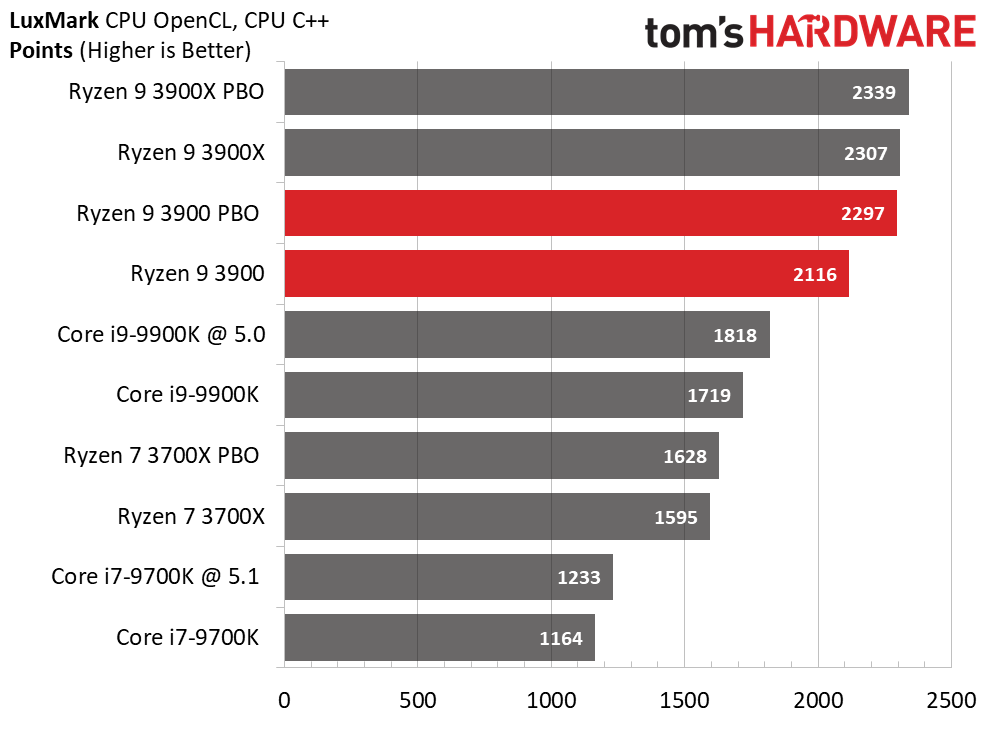

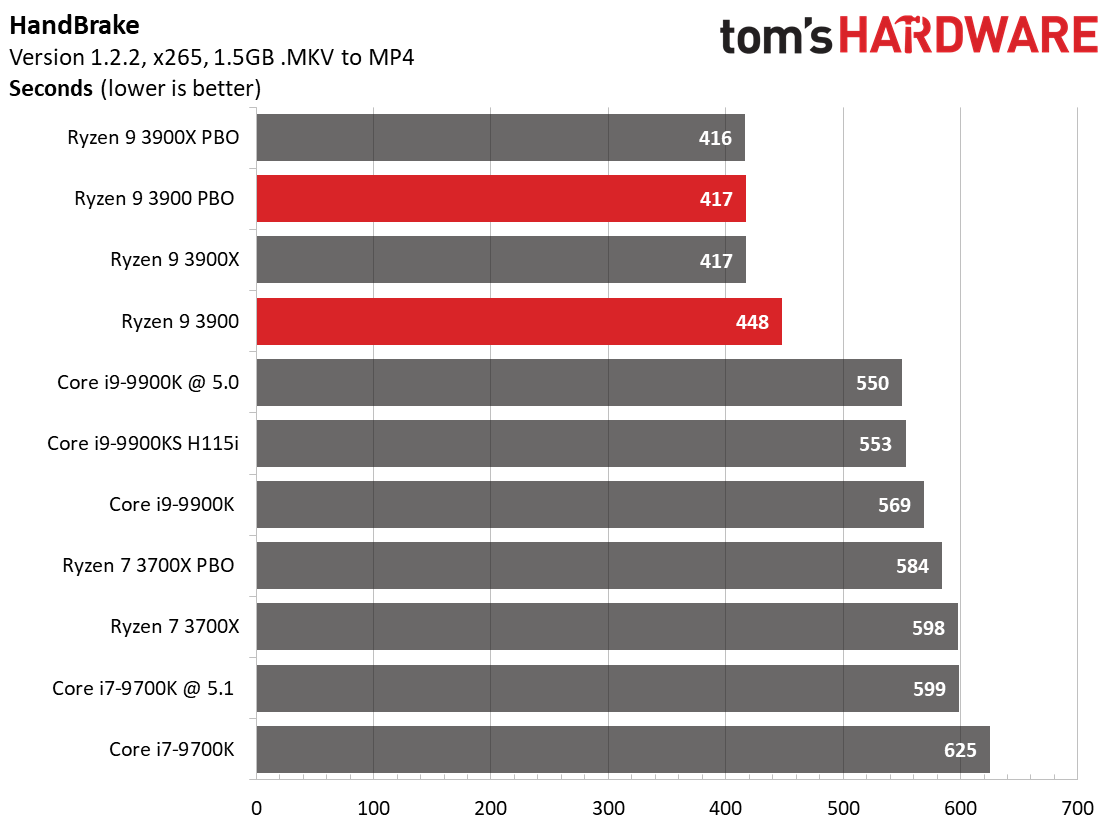


The gaming results speak for themselves. The stock Ryzen 9 3900 delivers nearly the same performance as the stock Ryzen 9 3900X, and surpasses it after tuning. You'd be hard-pressed to notice a difference with the naked eye, and these slim deltas will shrink further with high-resolution gaming. Intel's processors still hold the claim to the fastest gaming performance, bar none, but the Ryzen 9 3900 is plenty competitive given its lower power consumption. It also comes with the other advantages of AMD's platform, like stronger performance than Intel models in many threaded workloads.
Our application benchmarks revealed much the same trend. The difference between the 105W Ryzen 9 3900X and the 65W Ryzen 9 3900 is slim in most cases, with the 3900 offering a great mix of performance given its low power envelope.
AMD holds a big advantage with the PCIe 4.0 interface, which enables storage devices that are twice as fast as Intel's comparable models. AMD's PCIe 4.0 connection between the processor and chipset also opens the door for powerful RAID storage arrays. The lower power envelope also makes the chip more suitable for use with less-expensive motherboards that don't have beefy power circuitry.
Get Tom's Hardware's best news and in-depth reviews, straight to your inbox.
Unfortunately, AMD isn't making the Ryzen 9 3900 available for the retail market, so we don't have pricing information to share. However, when paired with a suitable cooling solution (which shouldn't be much of a task given the 3900's low power draw), it will make a powerful addition to the pre-built market.
For enthusiasts, the real story here is the advantages of dialing back the Ryzen 9 3900X via AMD's Eco Mode to a lower power envelope. If you're looking to build a portable frag box for LAN parties, or just a DIY NAS or PlexBox, the Ryzen 9 3900X's basic design offers a great option for tremendous threaded horsepower--and more than acceptable gaming--at a lower TDP that's sure to please the small form factor enthusiasts among us.
CONTENT
1: Cramming 12 Cores & 24 Threads into a 65W TDP
3: AMD Ryzen 9 3900 Application Testing
4: Conclusion
MORE: Best CPUs
MORE: Intel & AMD Processor Hierarchy
MORE: All CPUs Content

Paul Alcorn is the Editor-in-Chief for Tom's Hardware US. He also writes news and reviews on CPUs, storage, and enterprise hardware.
-
gggplaya Why not publish the IDLE power consumption, both just chip and total system consumption?? That's what really matter for people building a Plexbox or DIY NAS box.Reply -
Gillerer I believe an AMD representative has stated that AMD truncates the advertized clock speeds - removing the (mostly irrelevant) +50 MHz; That's why a CPU whose actual boost frequency is 4.35 GHz has a "4.3 GHz" printed on the box and in marketing materials. I think the rationale was along the lines of "it's prettier" or "it's easier to take in", or something.Reply
Due to the variations in motherboards, the 10 MHz digit isn't significant anyways; just a 100.5 MHz base clock would add +21.5 MHz to CPU speed at a 43 multiplier. -
svan71 "friendlier 65W TDP " ? I'd like a meaner 140 w version at 5GHZ, you can keep the friendlier versions.Reply -
iam2thecrowe Reply
Agree, publishing idle power is relevant, but anyone building a plexbox/nasbox/HTPC is going to opt for a much lower end CPU.gggplaya said:Why not publish the IDLE power consumption, both just chip and total system consumption?? That's what really matter for people building a Plexbox or DIY NAS box. -
gggplaya Replyiam2thecrowe said:Agree, publishing idle power is relevant, but anyone building a plexbox/nasbox/HTPC is going to opt for a much lower end CPU.
Not for me, I want more cores for transcoding. It takes about 2000 passmarks for every CPU encoded stream, so the 3900x can do 15 simultaneous streams. The 3900 will presumably do around 12 streams give or take.
GPU encoding looks terrible in Plex at low bitrates, like 3-6mbps, with tons of macroblocking on fast scenes. CPU encoding looks nice and clean at those bitrates. It might downgrade to 720p at those bitrates, but at least it's a clean image.
Another thing people do is use these processors as servers for virtual machines, again with the computers running 24/7. Idle power consumption matters again in this case as places like california have expensive electricity.
Also, some people can only have 1 computer, and not have a dedicated plexbox or NAS server. So they use their computer for gaming, work, video editing etc.... But leave it turned on 24/7 to act as a plex or file server. My coworker does this.
It would be awesome when reviewing CPU's in the future to have idle power consumption and the passmark score. It's something reviewers have been neglecting lately on most websites, and hard information to find. -
Paul Alcorn Replygggplaya said:Not for me, I want more cores for transcoding. It takes about 2000 passmarks for every CPU encoded stream, so the 3900x can do 15 simultaneous streams. The 3900 will presumably do around 12 streams give or take.
GPU encoding looks terrible in Plex at low bitrates, like 3-6mbps, with tons of macroblocking on fast scenes. CPU encoding looks nice and clean at those bitrates. It might downgrade to 720p at those bitrates, but at least it's a clean image.
Another thing people do is use these processors as servers for virtual machines, again with the computers running 24/7. Idle power consumption matters again in this case as places like california have expensive electricity.
Also, some people can only have 1 computer, and not have a dedicated plexbox or NAS server. So they use their computer for gaming, work, video editing etc.... But leave it turned on 24/7 to act as a plex or file server. My coworker does this.
It would be awesome when reviewing CPU's in the future to have idle power consumption and the passmark score. It's something reviewers have been neglecting lately on most websites, and hard information to find.
You're right, I feel it is a glaring omission, but hard to measure correctly. We ARE adding it though in some fashion. I solicited some suggestions here:
1189735229285707776View: https://twitter.com/PaulyAlcorn/status/1189735229285707776
feel free to weigh in either here or there with ideas of what you would like to see. Sorry for the delay on adding idle power, things have been...busy. -
gggplaya ReplyPaulAlcorn said:You're right, I feel it is a glaring omission, but hard to measure correctly. We ARE adding it though in some fashion. I solicited some suggestions here:
1189735229285707776View: https://twitter.com/PaulyAlcorn/status/1189735229285707776
feel free to weigh in either here or there with ideas of what you would like to see. Sorry for the delay on adding idle power, things have been...busy.
Yea, that would be awesome.
Personally I would just load windows, install all drivers and updates including motherboard driver updates and bios's. Set it to power savings plan or balanced and not install any programs. Let the machine sit for 45minutes.
Then measure the average power over say 10 minutes to get the idle power draw. -
bloodroses ReplyPaulAlcorn said:You're right, I feel it is a glaring omission, but hard to measure correctly. We ARE adding it though in some fashion. I solicited some suggestions here:
1189735229285707776View: https://twitter.com/PaulyAlcorn/status/1189735229285707776
feel free to weigh in either here or there with ideas of what you would like to see. Sorry for the delay on adding idle power, things have been...busy.
Would using something like Linux (command line or a bare window manager) be an option for testing idle power consumption since as you said Windows is well, Windows? It'd at least give a ballpark figure relative to (I assume) what Windows would use as well and be more consistent. You'd have to of course mention in the test that Linux is being used instead of Windows.
Another option could be something like Hiren's BootCD. -
King_V Reply
Lol, I'll admit I didn't see that coming, and it made me laugh!svan71 said:"friendlier 65W TDP " ? I'd like a meaner 140 w version at 5GHZ, you can keep the friendlier versions.